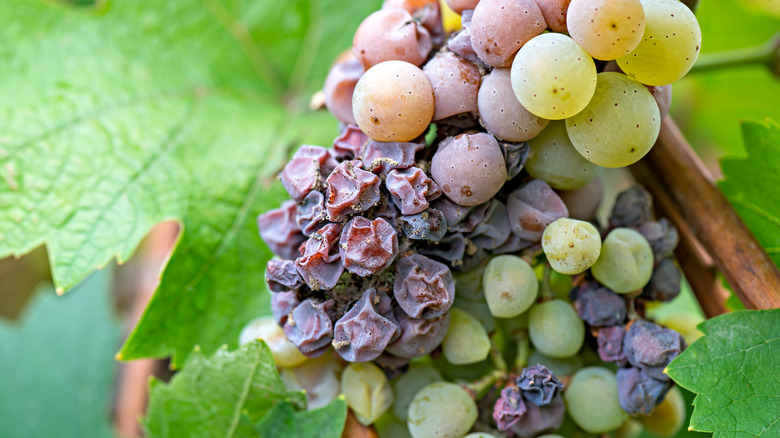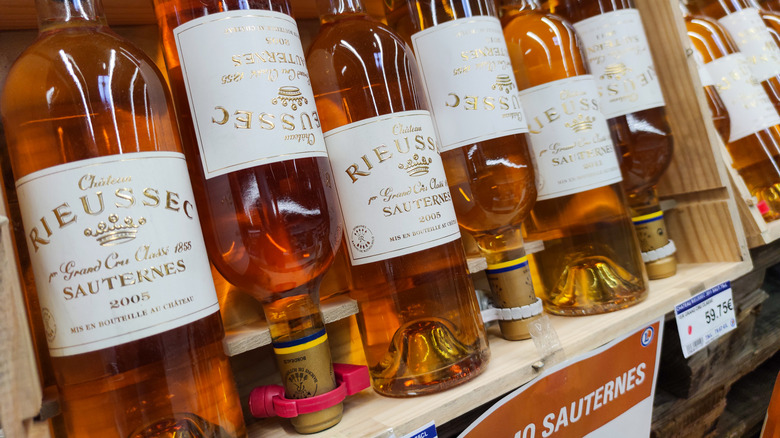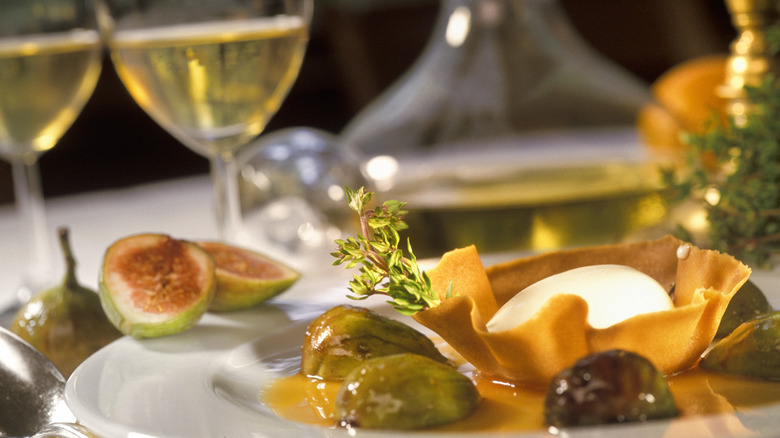How The Noble Rot Fungus Helps Produce A Rare, Highly Palatable Wine
Wine lingo can be funny sometimes. If you've ever had a glass of really good Sauternes — that incandescent wine that tastes like honeyed sunshine, concentrated, vibrant, and with a viscosity not found in many other wines — you've tasted the effects of a fungus. It doesn't sound appetizing, but it's true. The fungus is commonly called "noble rot," but its scientific name is botrytis, or more specifically, botrytis cinerea.
How does botrytis work? Very specific climactic conditions are required for botrytis to occur and when it does, the fungus attacks grapes, particularly thin-skinned grapes, and turns them into wrinkly, shriveled raisins. If the humidity, light, and temperature are just right, it's possible for botrytis to occur in a vineyard. The loss of moisture while the grapes are still on the vine concentrates the sugars and alters the flavors, also, in the process, making it possible for winemakers to produce exceptional dessert wines.
What wines are made from grapes affected by noble rot?
The most famous botrytised wines are those from a small area of Bordeaux, known as Sauternes. Typically made of Semillon, they're among the world's greatest and most highly rated wines. But Sauternes doesn't have a monopoly on botrytis. France's Loire Valley produces some botrytised wines, the loveliest of which are from Quarts de Chaume and made of Chenin Blanc.
Hungarian Tokaji Azsú is made from Furmint, Hárslevelű, and Yellow Muscat grape varieties that have been raisined by botrytis. German Riesling and other grape varieties labeled Beerenauslese and Trockenbeerenauslese are often affected by botrytis. Irreverent Australian winemaker Chester Osborne of d'Arenberg in Australia makes a botrytised Semillon-Sauvignon Blanc, as well as other wines from a number of white grape varieties. In fact, wines made from grapes with noble rot can be found in California, Austria, and France's Alsace region, though conditions that permit botrytis to occur are frequently unpredictable.
How do you serve botrytised wines?
Wines made from such concentrated grapes can be utterly mindblowing, full of saturated flavor, and balanced with acidity. They shouldn't be served too cold and they're typically served in relatively small quantities. As far as matching botrytised wines with food, Sauternes and foie gras is a classic pairing — the rich, savory nature of luxe foie gras and the sweetness of Sauternes match one another in intensity while balancing in a way that's both delightful and a bit perplexing.
If you're not a foie gras fan, the simplest pairings can be the best. A simple, rustic apple tart is a lovely foil for silky, sweet botrytised wines. And if you're looking for contrast, a salty, crystallized aged cheese and some roasted nuts will pose the perfect counterpoint to your special occasion sweet wine. Botrytised wines can overpower delicate flavors, however, so you'll want to pair them with care. These wines — made from shriveled, concentrated grapes — are most definitely worth seeking out. They're collectible, age-worthy, and utterly unique.


